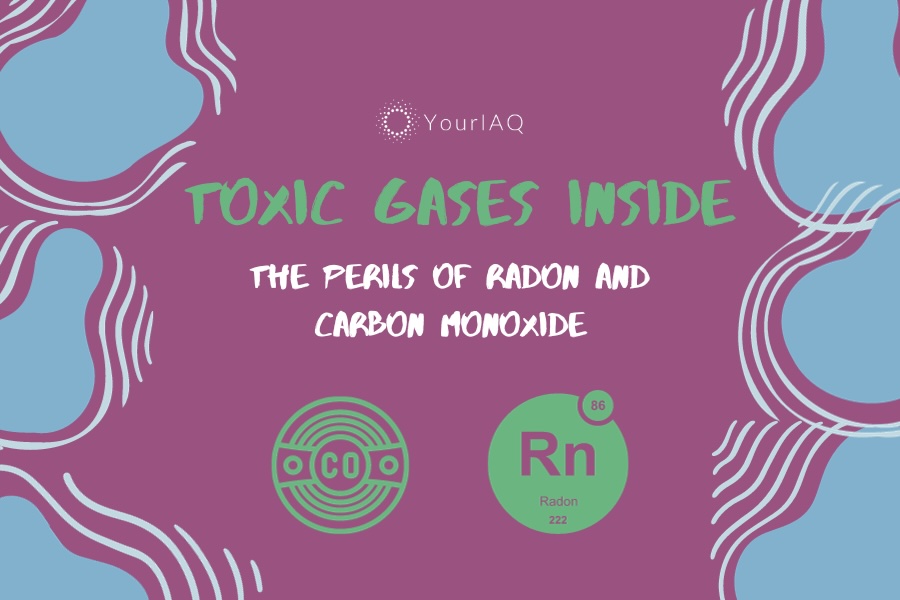
In this blog post, we’re diving into a crucial topic for every homeowner and renter: the presence of toxic gases in homes, specifically radon and carbon monoxide. These invisible threats can have serious implications for your indoor air quality and your family’s health. Let’s explore what they are, why they’re dangerous, and how you can protect your home and loved ones.
Invisibility of Radon and Carbon Monoxide
Unseen Not Unimportant
Radon and carbon monoxide share a common and dangerous trait: they are both invisible gases. This invisibility makes them particularly hazardous, as you can’t detect them by sight or smell. Understanding how these gases infiltrate our homes and the risks they pose is the first step in prevention.
Lung Cancer and Other Health Risks from Radon
The Silent Lung Health Menace
Radon is the second leading cause of lung cancer in America after smoking. It’s particularly common among non-smokers. Radon is a naturally occurring gas that can seep into your home from the ground. Prolonged exposure increases lung cancer risk, making radon testing and mitigation a vital aspect of home safety.
Radon’s Natural Occurrence and Seepage into Buildings
Earth’s Hidden Hazard
Radon originates from the natural breakdown of uranium in soil, rock, and water. It enters buildings through cracks in floors, walls, and foundations. Since there’s no safe level of radon, it’s essential to regularly test your home, particularly if you live in an area with high radon potential.
Read more: Radon Test Kits vs. Electronic Air Quality Monitors: Which is Right for You?
Symptoms and Severity of Carbon Monoxide Poisoning
Carbon Monoxide: The Silent Killer
Carbon monoxide, produced whenever fossil fuels are burned, can cause symptoms like headache, dizziness, and nausea. In severe cases, it leads to loss of consciousness and even death. An estimated 100,000 people are sent to emergency rooms in the U.S. each year from carbon monoxide poisoning, according to the CDC. Awareness of these symptoms and timely action can be life-saving.
Vulnerable Groups and Seasonal Risks of Carbon Monoxide Poisoning
Special Care for Sensitive Groups
Infants, the elderly, and individuals with chronic health conditions are more susceptible to carbon monoxide poisoning. Risks escalate in the winter due to increased use of heating systems. Ensuring proper ventilation and regular maintenance of heating appliances is crucial.
Carbon Monoxide as the ‘Invisible Killer’
Detection and Prevention
Often termed the “Invisible Killer,” carbon monoxide is responsible for over 150 accidental deaths annually in the U.S. It’s imperative to have CO detectors in your home and to be aware of the symptoms of CO poisoning for early detection and prevention.
Read more: Common Questions About Air Quality Monitors
Testing and Mitigation of Radon
Protecting Your Home
Testing for radon is simple and affordable. If high levels are detected, radon mitigation systems can significantly reduce its concentration. Consult with a qualified radon mitigation professional for the best solution for your home.
Frequently Asked Questions
How often should I test for radon?
Test every two years, or after any major home renovation. If you have genuine concerns that radon is a problem in your home’s foundation, consider getting an indoor air quality monitor with continuous radon sensing.
Where should I place carbon monoxide detectors?
Install them near bedrooms and on each level of your home.
Can I test for carbon monoxide myself?
Yes, with a CO detector. However, for any suspicion of CO, leave the house and immediately call a professional.
Are there symptoms to watch for radon exposure?
No, radon exposure doesn’t have immediate symptoms, which is why testing is crucial.
Conclusion
Understanding and mitigating the risks of radon and carbon monoxide are key to maintaining good indoor air quality. Regular testing and proper precautions can safeguard your home from these toxic gases. Stay informed, and stay safe.







